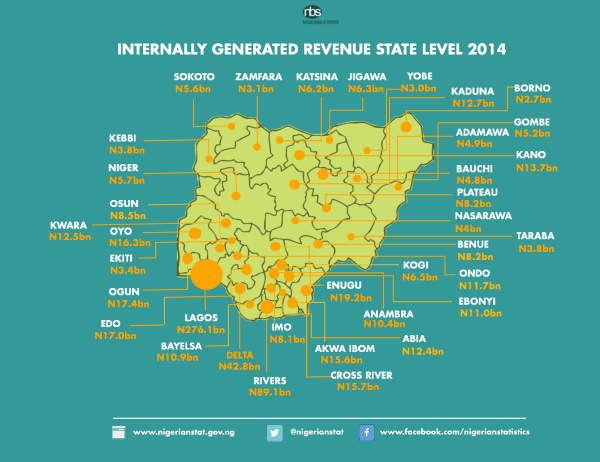Since Nigeria’s independence in 1960, states within the country have split several times to its present number, with the most recent split occurring in 1996. Since then, each state has had to survive on its internally generated revenue as well as a federal allocation from oil revenue, with many depending heavily on the latter. Due to dwindling oil prices and an increased level of debt, many government officials have started to emphasise the need for states to begin generating significant internal revenue in order to continue functioning.
However, it appears it is a little too late for states in the country. In 2015, analysts at Cardinal Stone, a Brokerage firm in Nigeria, predicted that “…with oil contributing about 70 per cent of Nigeria’s revenue, the drastic drop in oil price will significantly curtail government revenue and invariably, expenditure.” Pricewaterhouse Coopers (PWC) also predicted that “state governments could struggle to borrow from financial markets to pay their workers.” Civil workers of some states have not received their salaries for many months, despite the federal government offering states “bail-out” funds last year. It was also forecasted that the revenue of most of these states would be used to service debts in 2016, rather than used to pay salaries, which could lead to more strike action and bring activities within the state to a standstill. As it stands, a possible solution would be for some states to merge and combine resources again in order to battle the coming recession. However, the major reason cited for the initial splitting of states was the neglect of the minority groups by the government.
The top three states, in terms of internally generated revenue, include Lagos, Rivers and Delta states. Lagos is the only state, out of these three, that can boast of generating its own revenue aside from oil. Rivers and Delta states get the most allocation of oil revenue considering that most of the nation’s oil comes from the two states. However, that allocation is set to reduce due to the instability of oil prices internationally.
According to a 2015 report, states with the lowest Internally Generated Revenue (IGR) include Adamawa (part of the old Gongola state), Bauchi (Gombe split from it), Borno (Yobe state split from it), Ekiti (split from Ondo state), Kebbi (split from Sokoto), Nasarawa (split from Plateau state), Taraba (from the old Gongola state), Yobe (split from Borno), Zamfara (split from Sokoto state), Jigawa (split from Kano state), Benue (produced Plateau state), Niger (split from Sokoto state), Imo (gave way to the creation of Abia state) and Osun state (from Oyo state). However, the reason for some of the low IGR’s in these states can be justified based on their populations. And when compared to some other states in the south-west and south-east, the above states should be generating more considering they have more or less the same population with those states.


The Federal Government needs to review this policy of state-splitting and consider merging the less viable ones back with their former states in order to save resources and enhance generation of internal revenue. Thirty-six states for a nation like Nigeria is over stretching resources and disabling independence from the federal government. Argentina is three times bigger than Nigeria yet has fewer states. Now that Nigeria’s oil revenue has reduced drastically, perhaps it is a signal that it is time to merge states together.








